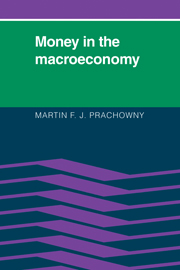Book contents
- Frontmatter
- Contents
- List of charts, figures, and tables
- Preface
- List of symbols
- 1 The roles of money and monetary policy in the macroeconomy
- 2 A model of the macroeconomy
- 3 The new classical model: the case against stabilization policy
- 4 The institutionalist model: the case for stabilization policy
- 5 The demand for money
- 6 The supply of money
- 7 The monetary mechanism
- 8 U.S. monetary policy and the dilemma of stagflation
- 9 A model of an open economy
- 10 Managed exchange rates and monetary policy
- 11 Monetary policy in Canada and its macroeconomic consequences
- 12 Improving the monetary policy apparatus
- Index
12 - Improving the monetary policy apparatus
Published online by Cambridge University Press: 26 October 2011
- Frontmatter
- Contents
- List of charts, figures, and tables
- Preface
- List of symbols
- 1 The roles of money and monetary policy in the macroeconomy
- 2 A model of the macroeconomy
- 3 The new classical model: the case against stabilization policy
- 4 The institutionalist model: the case for stabilization policy
- 5 The demand for money
- 6 The supply of money
- 7 The monetary mechanism
- 8 U.S. monetary policy and the dilemma of stagflation
- 9 A model of an open economy
- 10 Managed exchange rates and monetary policy
- 11 Monetary policy in Canada and its macroeconomic consequences
- 12 Improving the monetary policy apparatus
- Index
Summary
INTRODUCTION
In this closing chapter we need to look at some larger issues concerning monetary policy, issues that go beyond a critical assessment of the decisions made by the chairman of the Federal Reserve or by the governor of the Bank of Canada during the turbulent decade of the 1970s. We have already discussed at great length whether, in retrospect, the central banks in Canada and in the United States performed well in the various circumstances that they faced. We looked at questions such as Did they choose the right target? and Did they choose the best monetary mechanism? On the whole, it is easy to be critical of policy mistakes with the benefit of hindsight. To counter this temptation, we must be reminded that central banks were making decisions in an uncertain environment and facing new situations. Once we realize that very few critics could consistently outperform those in charge of the central bank, we obtain a better perspective from which to make reasonable judgments.
No matter what those judgments are, we now want to focus on a more fundamental issue of whether the central bank can ever be successful in achieving its macroeconomic objectives. The overriding problem may be that there is an inevitable incompatibility between public policy and private maximizing behavior and that the latter will always prevail.
Economic policy involves regulation of economic behavior.
- Type
- Chapter
- Information
- Money in the Macroeconomy , pp. 315 - 332Publisher: Cambridge University PressPrint publication year: 1986



